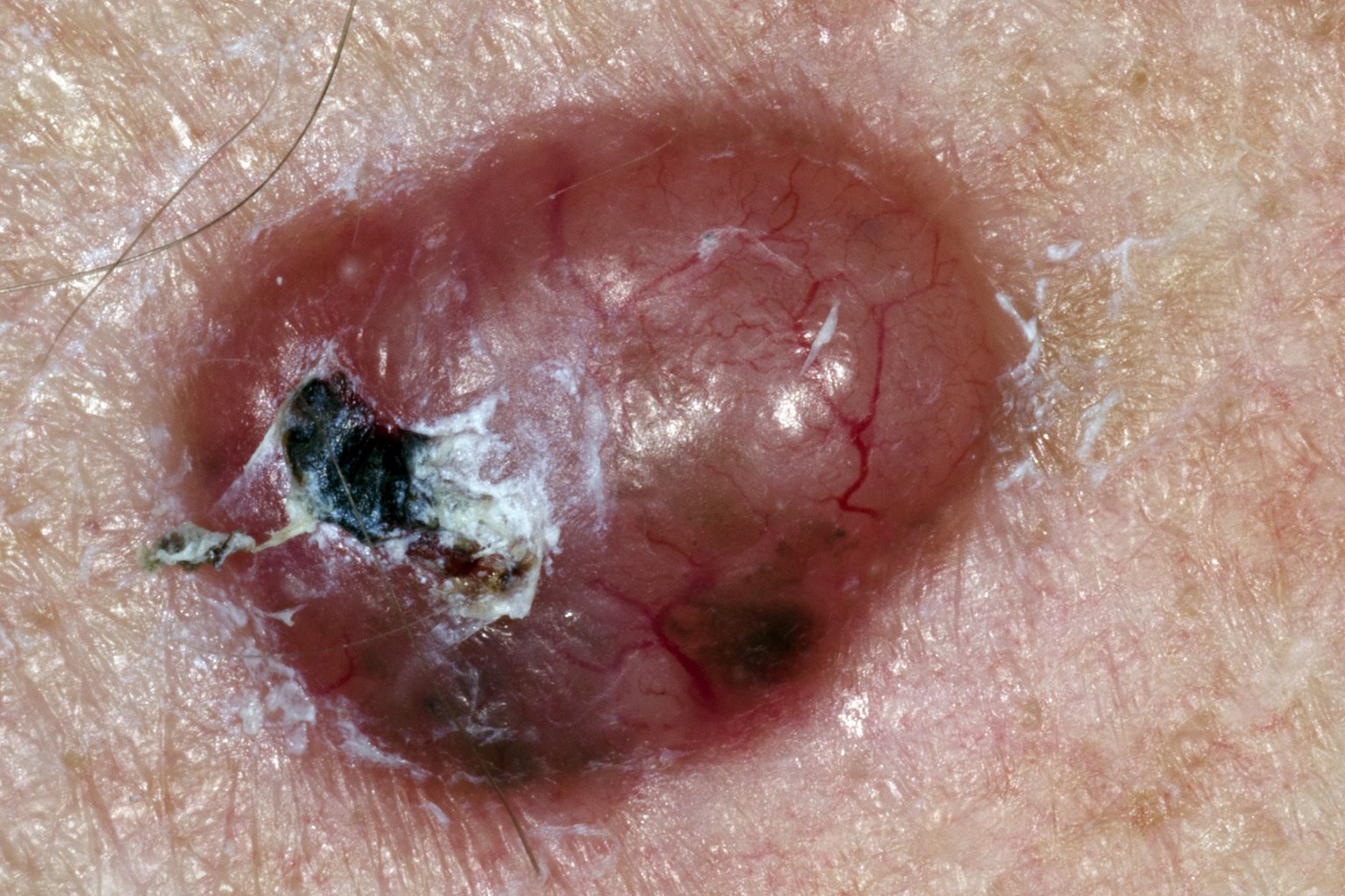Nonmelanoma Skin Cancer: Symptoms, Causes, Treatment
What are the symptoms of non-melanoma skin cancer?
Non-melanoma skin cancer is a type of cancer that typically develops on sun-exposed skin, such as the face, ears, neck, lips, and backs of the hands. The two main types of non-melanoma skin cancer are basal cell carcinoma (BCC) and squamous cell carcinoma (SCC).
Symptoms of non-melanoma skin cancer can vary depending on the type and location of the cancer, but common signs and symptoms may include:
- Unusual Growth or Sore: A persistent, pearly or waxy bump, or a flat, flesh-colored or brown scar-like lesion that won’t heal, or a red, firm nodule.
- Red or Pink Patches: Flat, scaly, reddish or brownish patches that may crust or bleed.
- Raised, Rough, or Scaly Bumps: Raised, reddish, or brownish, rough, scaly, or crusty lesions that may bleed easily.
- Open Sores: An open sore that persists for weeks, heals and then reopens, may ooze or crust.
- Changes in Existing Moles or Lesions: Any change in size, shape, color, or texture of an existing mole or lesion.
- Itching, Tenderness, or Pain: Any new or existing lesion that itches, feels tender, or causes pain.
- Bleeding or Oozing: Any lesion that bleeds, oozes, or crusts over and doesn’t heal.
It’s important to note that non-melanoma skin cancers often do not cause any symptoms in the early stages. Regular skin examinations and early detection are key to successful treatment. If you notice any new or changing skin lesions, it’s important to have them evaluated by a healthcare professional, especially if they persist or exhibit any of the above symptoms.
What are the causes of non-melanoma skin cancer?
Non-melanoma skin cancer, including basal cell carcinoma (BCC) and squamous cell carcinoma (SCC), is primarily caused by exposure to ultraviolet (UV) radiation from the sun or from tanning beds. Other factors that may increase the risk of developing non-melanoma skin cancer include:
- Sun Exposure: Chronic or excessive exposure to sunlight, especially in fair-skinned individuals, increases the risk of developing non-melanoma skin cancer. This includes sunburns during childhood or adolescence.
- Indoor Tanning: The use of tanning beds or sunlamps increases the risk of developing skin cancer due to exposure to UV radiation.
- Age: The risk of non-melanoma skin cancer increases with age, as cumulative exposure to UV radiation over time increases the risk.
- Fair Skin, Hair, and Eyes: People with fair skin, light-colored hair, and blue or green eyes are at higher risk due to lower levels of melanin, which provides some protection against UV radiation.
- History of Skin Cancer: A personal history of non-melanoma skin cancer increases the risk of developing additional skin cancers.
- Family History: A family history of skin cancer, especially in close relatives, increases the risk of developing non-melanoma skin cancer.
- Immune Suppression: People with weakened immune systems, such as those with HIV/AIDS or those taking immunosuppressive medications, are at higher risk.
- Exposure to Certain Chemicals: Exposure to certain chemicals, such as arsenic, coal tar, and certain industrial compounds, may increase the risk of developing skin cancer.
- Radiation Therapy: Previous radiation therapy for other conditions may increase the risk of developing skin cancer in the treated area.
- Chronic Skin Inflammation or Injury: Chronic skin inflammation or injury, such as from burns, scars, or chronic ulcers, may increase the risk of developing skin cancer in the affected area.
It’s important to protect your skin from UV radiation by using sunscreen, wearing protective clothing, and seeking shade, especially during peak sun hours. Regular skin examinations and early detection are key to successful treatment of non-melanoma skin cancer.
What is the treatment for non-melanoma skin cancer?
The treatment for non-melanoma skin cancer, such as basal cell carcinoma (BCC) and squamous cell carcinoma (SCC), depends on the type, size, location, and extent of the cancer, as well as the patient’s overall health and preferences. Treatment options may include:
- Surgery: Surgical removal of the cancerous lesion is often the primary treatment for non-melanoma skin cancer. This can be done using various techniques, including excisional surgery, Mohs surgery (a specialized technique that minimizes damage to healthy tissue), and curettage and electrodesiccation (scraping away the cancerous tissue and using an electric current to destroy any remaining cancer cells).
- Topical Medications: For certain superficial BCCs or SCCs, topical medications such as imiquimod or 5-fluorouracil (5-FU) may be used to destroy the cancerous cells.
- Radiation Therapy: Radiation therapy may be used for BCCs or SCCs that are difficult to treat with surgery or in cases where surgery is not possible. It may also be used after surgery to reduce the risk of recurrence.
- Cryotherapy: Cryotherapy involves freezing the cancerous tissue with liquid nitrogen, causing it to slough off. This is often used for small, superficial BCCs or SCCs.
- Photodynamic Therapy (PDT): PDT involves applying a photosensitizing agent to the skin and then exposing it to a light source, which activates the agent and destroys the cancerous cells. PDT is often used for superficial BCCs or SCCs.
- Biologic Therapy: Biologic therapy, such as the use of imiquimod or interferon, may be used in certain cases to stimulate the immune system to attack the cancer cells.
- Chemotherapy: In some cases, chemotherapy may be used, especially for advanced or metastatic non-melanoma skin cancers that have spread to other parts of the body.
- Targeted Therapy: Targeted therapy may be used for advanced non-melanoma skin cancers that have specific genetic mutations. Drugs such as vismodegib and sonidegib target the hedgehog pathway, which is often activated in BCCs.
The choice of treatment depends on several factors, and a healthcare provider will work with the patient to develop a treatment plan that is tailored to their specific needs. Early detection and treatment of non-melanoma skin cancer are important for the best outcomes.




